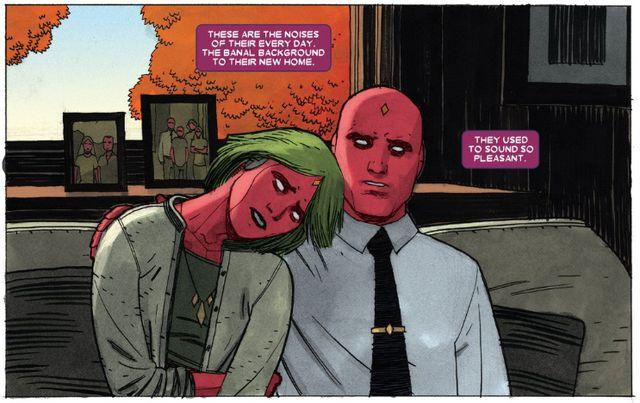I recently had a discussion with my sister in which she was going on and on about how recent additions to the Marvel Cinematic Universe, such as Ant-Man and Doctor Strange, were “stupid” characters. I explained that, first off, Doctor Strange is actually not stupid, he’s the sickest character of all. He also typifies modern-day Marvel Universe’s skill for taking campy, kind of silly, and outdated characters and placing them in a contemporary setting.
One of the best examples of this ingenuity is the character of the Vision—created by Stan Lee, Roy Thomas, and John Buscema in 1968—and his introduction to the current MCU roster. Paul Bettany brilliantly portrayed the all-powerful AI in its debut in 2015’s Avengers: Age of Ultron, a mysterious and ridiculously colorful force who turns out to be one of the strangest and most exciting parts of the team. But on paper, the Vision’s origin is a silly one, heavily rooted in the dramatic sci-fi of the 1960s: the Vision is a “synthezoid” created by the genocidal robot Ultron to lure the Avengers—his greatest foes—into a trap. But deep within his programming, the Vision is motivated to help save humanity rather than destroy it, and joins the team as one of its most powerful members.
Perhaps due to the popularity of the Marvel movies, the Vision was given his very first solo series last year, and it’s the best comic of 2016.
Written by Tom King, The Vision takes the title character out of his usual role as one of Earth’s mightiest heroes and transforms him into a suburban family man. In an attempt to become more normal, Vision pulls a Dr. Frankenstein and builds his own family—wife Virginia, son Vin, and daughter Viv—while taking a job at the White House and setting up home in Arlington, Virginia. The setup sounds cutesy, and the smiling synthezoids on the cover of the first issue give off a quaint vibe, but the story that unfolds over the next 12 issues takes a dark turn.
Unable to adjust to normal civilian life and everyday human interactions, the family continuously get caught up in heartbreaking, deadly blunders. They become increasingly unsatisfied with their existence as they explore their own programming, attempting to get a better grasp on typical human life. As the story progresses a wrinkle emerges: the Vision may be an indestructible creation that has singlehandedly saved the Earth from doom exactly 37 times, but he’s unable to manage a happy and healthy household. Each issue delivers one crushing blow after another: betrayal, teenage heartbreak, depression, and suicide.
Artist Gabriel Hernandez Walta and colorist Jordie Bellaire greatly contribute to The Vision‘s emotional impact. The dark browns and grays of the Vision’s stark, suburban house provide a gloomy, drab setting for an equally sad story; in contrast, the android family is painted in brilliant colors—emerald green, ruby red, and sunshine yellow.
But it’s King’s concepts that stand out most of all. The line drawn between human and machine is fine. At times it’s blurred: with each step toward normalcy and humanity, the family confronts gutting reminders that they’ll never achieve such an existence. King makes the members of the Vision family glitch and malfunction when they experience death and trauma, which produces a devastating and precise effect.
This is a true feat for Marvel, and especially for King. I wish the story went longer, but I’m excited to continue following his work on The Sheriff of Babylon and the current run of Batman.

The Vision By Tom King, illustrated by Gabriel Hernandez Walta and Jordie Bellaire (Marvel)





